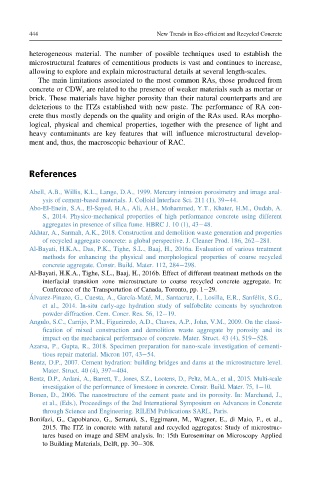Page 494 - New Trends in Eco efficient and Recycled Concrete
P. 494
444 New Trends in Eco-efficient and Recycled Concrete
heterogeneous material. The number of possible techniques used to establish the
microstructural features of cementitious products is vast and continues to increase,
allowing to explore and explain microstructural details at several length-scales.
The main limitations associated to the most common RAs, those produced from
concrete or CDW, are related to the presence of weaker materials such as mortar or
brick. These materials have higher porosity than their natural counterparts and are
deleterious to the ITZs established with new paste. The performance of RA con-
crete thus mostly depends on the quality and origin of the RAs used. RAs morpho-
logical, physical and chemical properties, together with the presence of light and
heavy contaminants are key features that will influence microstructural develop-
ment and, thus, the macroscopic behaviour of RAC.
References
Abell, A.B., Willis, K.L., Lange, D.A., 1999. Mercury intrusion porosimetry and image anal-
ysis of cement-based materials. J. Colloid Interface Sci. 211 (1), 39 44.
Abo-El-Enein, S.A., El-Sayed, H.A., Ali, A.H., Mohammed, Y.T., Khater, H.M., Oudab, A.
S., 2014. Physico-mechanical properties of high performance concrete using different
aggregates in presence of silica fume. HBRC J. 10 (1), 43 48.
Akhtar, A., Sarmah, A.K., 2018. Construction and demolition waste generation and properties
of recycled aggregate concrete: a global perspective. J. Cleaner Prod. 186, 262 281.
Al-Bayati, H.K.A., Das, P.K., Tighe, S.L., Baaj, H., 2016a. Evaluation of various treatment
methods for enhancing the physical and morphological properties of coarse recycled
concrete aggregate. Constr. Build. Mater. 112, 284 298.
Al-Bayati, H.K.A., Tighe, S.L., Baaj, H., 2016b. Effect of different treatment methods on the
interfacial transition zone microstructure to coarse recycled concrete aggregate. In:
Conference of the Transportation of Canada, Toronto, pp. 1 29.
´
Alvarez-Pinazo, G., Cuesta, A., Garcı ´a-Mate ´, M., Santacruz, I., Losilla, E.R., Sanfe ´lix, S.G.,
et al., 2014. In-situ early-age hydration study of sulfobelite cements by synchrotron
powder diffraction. Cem. Concr. Res. 56, 12 19.
Angulo, S.C., Carrijo, P.M., Figueiredo, A.D., Chaves, A.P., John, V.M., 2009. On the classi-
fication of mixed construction and demolition waste aggregate by porosity and its
impact on the mechanical performance of concrete. Mater. Struct. 43 (4), 519 528.
Azarsa, P., Gupta, R., 2018. Specimen preparation for nano-scale investigation of cementi-
tious repair material. Micron 107, 43 54.
Bentz, D.P., 2007. Cement hydration: building bridges and dams at the microstructure level.
Mater. Struct. 40 (4), 397 404.
Bentz, D.P.,Ardani, A.,Barrett, T.,Jones,S.Z., Lootens, D., Peltz, M.A., et al., 2015. Multi-scale
investigation of the performance of limestone in concrete. Constr. Build. Mater. 75, 1 10.
Bonen, D., 2006. The nanostructure of the cement paste and its porosity. In: Marchand, J.,
et al., (Eds.), Proceedings of the 2nd International Symposium on Advances in Concrete
through Science and Engineering. RILEM Publications SARL, Paris.
Bonifazi, G., Capobianco, G., Serranti, S., Eggimann, M., Wagner, E., di Maio, F., et al.,
2015. The ITZ in concrete with natural and recycled aggregates: Study of microstruc-
tures based on image and SEM analysis. In: 15th Euroseminar on Microscopy Applied
to Building Materials, Delft, pp. 30 308.

